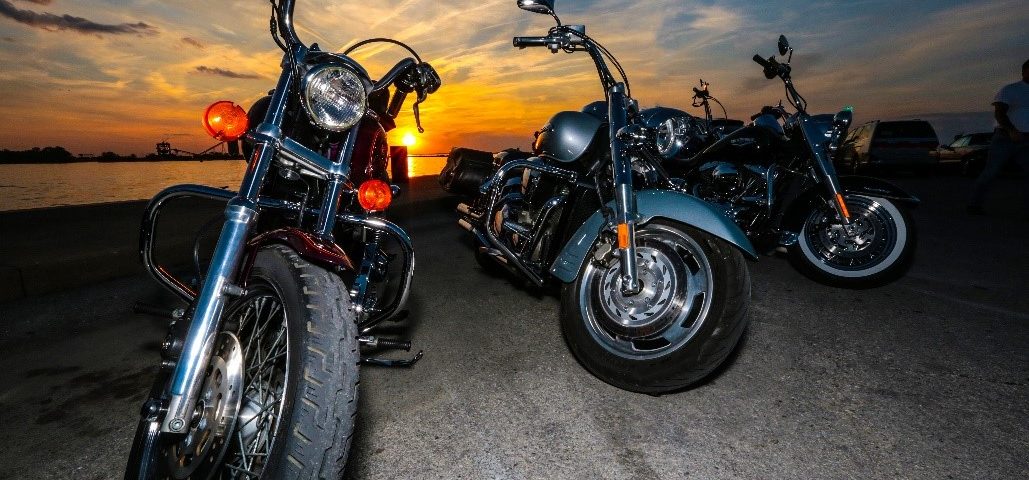
About five years ago, my buddy Jeff said he wanted to turn a Sportster into an adventure bike. With a look of abhorrence forming on my face, I said, “Why on earth would you want to ride a Harley off-road?”
Fast forward a few years, after a riding Triumph Scrambler over every surface imaginable, meanwhile piling on enough miles to necessitate multiple valve checks each year, suddenly the idea of a pushrod engine started to sound like a good idea. I tapped my buddy Jeff on the shoulder and asked, “How serious are you about scrambling a Sporty?”
Why a Sportster
I love adventure riding, for a myriad of reasons (sounds like a follow-on article). With that, there’s no denying I like “adventure” motorcycles; with taller seats to see over traffic, upright seating position that’s more agreeable with my lower back, and long-travel suspension to suck up the bumps, there’s a lot to appreciate. That said, I still have beef with the modern adventure bike, mostly the price associated with all the extra crap I really don’t need. Don’t get me wrong, I’m all about heated grips and electronic cruise control. I welcome ABS, and I’ll tolerate traction control and throttle mapping. However, I really have no need for the whiz-bang TFT display and the subsequent techno-farkles that come with it. I can appreciate the “half fairing” and the tall windshield for burning down the highway, but honestly, that’s really not the kind of riding I enjoy.
Enter the Sportster. Perhaps I was born a couple generations too late, but I put a hallmark on simplicity. With the addition of the Evolution engine in 1986, the Harley-Davidson Sportster has been mostly unchanged over the last three decades. Yes, engines have been fuel injected, rubber mounted, and various other minor improvements have been made, but it’s still the stone ax simple, forty-five-degree Milwaukee twin at the heart of the motorcycle. All of the previously mentioned electronic gizmos are awesome, I even own a few, but when the wheels leave the pavement, their importance is diminished. For a do it all machine, the Sportster with its Evolution engine has a lot of overlooked potential.
In its modern slammed and chromed form, the unassuming Sportster is no dirt machine. You’ll find no argument here, again, it’s the engine, model longevity, and years of aftermarket support that makes the Sportster a logical platform for a garage built adventure machine. The Evo’s pushrod mill means that I just need to change oil and ride the snot out of it, repeat as necessary. With thirty years of service, there’s a myriad of parts available to transform a Sporty from a bar-hopper to a scrambling adventure machine.
For years, many have jested about the agricultural nature of the Harley-Davidson engine. Certainly, I appreciate the advancements of dual-overhead-cams and liquid cooling, however, I’m not looking for more horsepower in the dirt. I am, in fact, looking for a tractor. Regardless of modifications, a Sportster is still going to be a heavy “dirt bike”; I want stump pulling torque, not wound out, peaky engine character when I’m navigating a V-twin assault vehicle through the green-lanes.
Without pontificating about the current motorcycle sales trends, let’s just agree that the used market is strong. This is another logical reason to convert a Harley Sportster into a forest trail explorer. Used Sportsters can be found just about anywhere, for just about any price. It doesn’t hurt that many consider the Sportster an “entry-level” motorcycle, making available options that much more plentiful. Considering you’re no longer shopping based on “looks”, you can also save a few more bucks by buying a bike with only the critical components intact.
How Do You Scramble a Sportster?
Certainly, my profuse affection for the aging Evolution engine isn’t sufficient to convince you a Sportster is an ideal off-road platform. Agreed, the oddly sized stock chrome rims are boat anchors, low slung pipes seem problematic, and the stubby rear shocks are, in a word, anemic. While not a direct comparison, let’s not forget the XR750 has been racing around dirt ovals for decades. Folks have been scrambling the “little” Harley for a long time, so this road map already exists.
In my mind, the engine is the critical component, and with it the frame (despite its heft). Travel on the front forks isn’t exactly immense, but for “leisurely” overlanding, it will do. If the five inches of travel on my Triumph Scrambler has done this much, the Sportster’s front end can accomplish the same. Being a Harley, there are at least a dozen aftermarket solutions for upgrading the fork innards to handle a little extra abuse. Those rear shocks, however, are destined for the dumpster; again, akin to my Triumph, four to five inches of absorption will be necessary to handle the ill-maintained backcountry byways.
Wheels is another issue. While there are stock Sportsters fitted with nineteen or even twenty-one inch spoked front wheels, it’s that sixteen-inch rear wheel that makes tire selection so complicated. Fifteen and sixteen inch rear wheels are no big deal when shopping street tires, but when shopping for knobby skins for your adventure machine, I can count the available options on one hand. Depending on how aggressive you decide to go, you’re going to want a 17 or 18-inch rear hoop to mount suitable off-road rubber.
The before mentioned pipes are potentially a problem. If you’re gingerly exploring the local forest service roads, any bike with any exhaust will do. If you plan on scrambling up jeep trails, along with the occasional log crossing, “high pipes” serve a purpose. Fortunately, this is another place where the Sportster shines, there’s absolutely no shortage of aftermarket exhaust options; considering the recent Scrambler craze, “high-pipes” can even be had for cheap.
Suspension, wheels, and exhaust are the big ticket items that immediately come to mind. All of which have been done before, so it will simply be a matter of choosing the formula that offers the best performance without breaking the bank. After those pieces, it’s a matter of finding wide bars, pinning down a suitable seat, and deciding on a chain conversion or keeping the belt drive.
While Jeff and I discussed the details of building this “Dirtster”, I came across an article on Revzilla Common Tread about a small company in Florida that was building kits to scramble Sportsters into the exact adventure machine we’d been discussing. Still in its infancy, I reached out to Hugo Moto for more details about the products they were offering. About two seconds later, Jeff told me a new (to him) Sportster followed him home. Quite a few pints were consumed at the local pub as Jeff and I scratched notes in a legal pad as we pored over the details of a possible build. After a few conference calls with the Hugo Moto guys, a box of parts arrived at Jeff’s garage in Cincinnati.
What’s in the Kit?
As I said, we weren’t the first to have this harebrained idea. There are countless builds documented on the Adventure Rider forums, along with a sea of scrambled Sportys to be found on any google search. Hugo Moto, however, took this idea and turned it into a series of bolt-on kits that builds a foundation to build your ultimate v-twin scrambler.
Great minds think alike, as they say, Hugo Moto’s business model is focused on addressing the exact concerns I expressed above. For riders just dipping their toe into the scrambling adventure scene, the basic kit starts with a peg relocation kit, high pipes, and a skid plate. Riders that are looking to test their skills deeper in the woods will want to upgrade to the stage 2 scrambler kit to add upgraded suspension components: front fork cartridge emulators and damper rods paired with upgraded shocks in the rear, plus a set of wide handlebars. Riders looking for the “Full Monty” will want to lean toward the HD2 Enduro kit, featuring longer travel premium suspension components, chain conversion kit, high fender mount, fork brace, enduro seat, and a set of knobby tires. In recent days they’ve also started to sell some of these components à la carte, namely the chain conversation and peg relocation kits. Jeff and I were bent on taking this Harley into the Kentucky backcountry, if not further, so for us, the long travel suspension and other premium bits were a must. Properly sized dirt wheels were also on tap, along with chain conversion, and the rest of the off-road staples.
Sportster to Dirtster in 48 hours
I had my mind about made up about attending the March Moto Madness rally before any talk of scrambling a Harley even started. When the possibility of meeting up with the Hugo Moto crew entered the conversation, that goal firmed up post-haste. Unfortunately, those before mentioned parts arrived at Jeff’s place just days before we needed to head south for the rally; the pressure was on.
There’s no question, I get all twinkle-eyed when I see the latest high-pipe scrambled motorcycle on the Bike EXIF feed, but the truth is, a lot of the stuff you find on the internet was put together by a custom builder with fabrication skills beyond many of us mortals. With that in mind, Hugo Moto put their scrambler package together as a “bolt-on” part replacement program. The front suspension, while intimidating, is easier than one might think. It is fair to say that the front forks are probably the most labor-intensive part of the install, but it’s doable for the layman with a little help from YouTube, or in my case, a buddy that’s rebuilt a lot of forks. In a similar fashion, Jeff had the correct size sockets to remove the giant nut holding on the front drive pulley. Even with those tools, a copious amount of PB blaster (and cuss words) were required to remove the front pulley from the countershaft for the chain conversion. With those two big ticket items out of the way, it was simply a matter of unbolting wheels, fenders, chain guards, pegs, and covers, replacing them with Hugo Moto parts and associated hardware and fasteners included in the kit. I could easily go into intricate detail about the exhaustion of pizza, cigars, expletives, and a lot of beers, but for the sake of brevity, take my word for it that over the course of two late nights after work, Jeff and I successfully swapped all of the critical components to build a 460-pound V-twin dirt bike in two days. (Details pending on MotoAdventurer.com)
How is it Off-Road?
When riding a big bike successfully off-road, tire selection plays a big role. We chose the 21″/18″ wheel setup to get a wider range of options, and then fitted them with Continental’s staple TKC80 for their respectable on-road/off-road capability. Charging up the hill in Tennessee on the freshly minted Dirtster, the knobby shod 21″ front wheel was a real game changer after having lived with a 19″ front wheel on my Scrambler for so long. Plowing over rain ruts and baby-head rocks, the upgraded suspension handled a lot more punishment than I’m accustomed to on a big bike. Compared to my portly Scrambler, the Sporty is tall and narrow, letting it squeeze through places where the big 1200 bikes might struggle. The Sportster does carry its weight a little higher, especially with the longer suspension travel. Fortunately, the Milwaukee V-twin has torque for days so you can lug it like a tractor when you need to thread the needle around obstacles.
Simplicity and reliability, of course, come at a cost. It’s a fine line between having the tools and skill to hit obstacles at speed, while also having the suspension set where you can still get a foot down in a pinch. Saving a 500-pound adventure machine from a tip-over is typically a lost cause, “discretion is the better part of valor” as they say. At 460 pounds, the new Dirtster is far from light, but still well under the curb weight of virtually all the heavy-weight adventure bikes. That said, if you’re going to have heart burn about potentially scratching your Harley, riders cruising at lower altitudes would be wise to stick with the shorter travel suspension versus the Hugo Moto long-travel options.
Needless to say, the rider has as much to do with it as the machine; I don’t have those skills, but I appreciate where the Dirtster can take me. Jason Smith however, President at Hugo Moto, does have the skills. One of the best parts of March Moto Madness is that they host a series of “field games”, from a trials course, to barrel races, to hill climb challenge. Jason entered their HD2 Enduro 1200 into the heavy-weight hill climb event on Sunday. Facing off against a series of other multi-cylinder bikes, including at least one certified BMW instructor, to the shock of many (myself included), it was the Harley that took the hill.
In the end, if you’re looking for single-track riding, a Harley Dirtster is no substitute for a dedicated single-cylinder woods weapon. However, if you’re looking to log long days in the saddle, where travel and experience are the goals, there’s little fear and turning down the next section of double-track you see. There’s nothing like putting together your own bike, and for the price of a used sporty and a few premium bits, your stone ax scrambler is sure to give those “beaked” ADV bikes a run for their money.
Notes: I wrote this as an independent story that’s actually a follow on from my original story way back when (https://motoadventurer.com/2018/02/25/harley-dirtster-project-planning/). I’m hoping to have a long version of “Stage 1 of the Dirtster Project” that includes more photos and video of the build up soon.
March Moto Madness Full Story: https://motoadventurer.com/2018/04/05/march-moto-madness-scrambler-adventures/
American Scrambler: From Sportster to Dirtster in 48 Hours or Less



